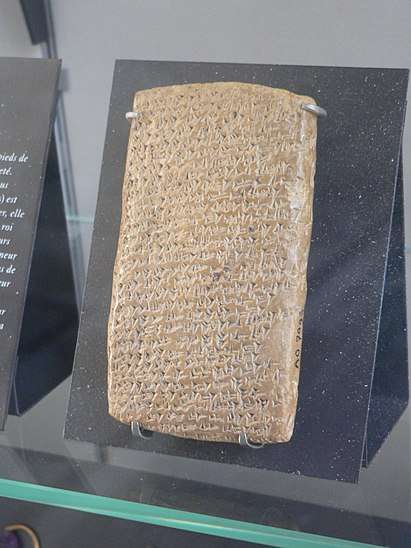Aš (cuneiform)
The cuneiform Aš sign, is found in both the 14th century BC Amarna letters and the Epic of Gilgamesh. In the Epic, it has the following meanings, besides aš:[1]
- aš
- dil
- ina
- ṭel
- AŠ


(high resolution, expandible photo)
Some special considerations for a single "cuneiform sign" are as follows. In Egyptian hieroglyphs, the space for a group of signs (in cuneiform, a group of individual strokes), is called (quadrat)-block. Among cuneiform signs, only a handful of signs (specifically the individual 'strokes', horizontal, vertical, "wedge", 'half-strokes', etc.) are found in single usage. For aš specifically, (the full-length, horizontal stroke) its highest usage in the Epic of Gilgamesh is for the preposition ina (for in, into, etc.; confer for a specific "ina" usage (by Kovacs), Gilgamesh flood myth#Alternative translations). The specific usage numbers for the sign's meaning in the Epic is as follows: aš-(4), dil-(3), ina-(284), ṭel-(1), AŠ-(1).[2] The high usage as the preposition may be for space considerations, but it should be considered that the Epic of Gilgamesh was also a "training document" for scribes, over hundreds of years, so the multi-functioning of signs may also have been in issue, (one cuneiform sign substituted for the preposition: i-na, of two signs.)
Usage in the Amarna letters
The most common use of cuneiform aš in the Amarna letters is for the spelling of "šapāru", for to send, to send in writing.[3] Besides the usage for "šapāru" in EA 362 (pictured), it is also used to spell šapāru in EA 34, titled The Pharaoh's reproach Answered, [4] line 8, Obverse—spelled, ta-aš--tap-ra.
Amarna letter EA 28, titled Messengers Detained and a Protest,[5] uses aš for the spelling of "aššum",[6] Akkadian language because of-(concerning, regarding), and in EA 28, line 24, obverse, Paragraph III, Tushratta, (of Mitanni) continues in his letter: ... "regarding" (the)-Messengers (i.e. Pirissi and Tulubri)....
References
- Parpola, 197l. The Standard Babylonian Epic of Gilgamesh, Sign List, pp. 155-165, no. 001, AŠ, p. 155.
- Parpola, 197l. The Standard Babylonian Epic of Gilgamesh, Sign List, pp. 155-165, no. 001, AŠ, p. 155.
- Rainey, 1970. El Amarna Tablets, 359-379, Glossary:Vocabulary, šapāru, pp. 55-87, p. 81.
- Moran, William L. 1987, 1992. The Amarna Letters. EA 34, The Pharaoh's reproach Answered, pp. 105-107.
- Moran 1987, 1992. The Amarna Letters. EA 28, Messengers detained and a protest, pp. 90-92.
- Parpola, 197l. The Standard Babylonian Epic of Gilgamesh, Glossary, pp. 119-145, aššum, p. 122.
- Moran, William L. 1987, 1992. The Amarna Letters. Johns Hopkins University Press, 1987, 1992. 393 pages.(softcover, ISBN 0-8018-6715-0)
- Parpola, 197l. The Standard Babylonian Epic of Gilgamesh, Parpola, Simo, Neo-Assyrian Text Corpus Project, c 1997, Tablet I thru Tablet XII, Index of Names, Sign List, and Glossary-(pp. 119–145), 165 pages.
- Rainey, 1970. El Amarna Tablets, 359-379, Anson F. Rainey, (AOAT 8, Alter Orient Altes Testament 8, Kevelaer and Neukirchen -Vluyen), 1970, 107 pages.
|
|
|